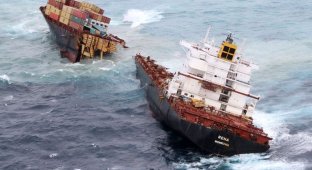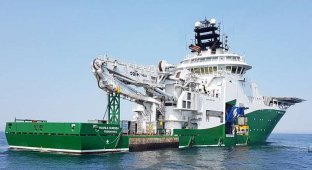Sizes of ships and classification of ships by size (16 photos)
The week has been difficult and I need to take a little break from heavy thoughts. So let's talk about boats.

In the global merchant fleet, it is customary to divide ships into types that are determined by the properties of the cargo being transported: tankers, container ships, gas carriers, bulk carriers, bulk carriers, and so on. But there is a classification of ships by size.
This classification takes into account the characteristics of the navigation area, namely the depths in the straits and port waters, the dimensions of the locks, and navigation conditions on artificial canals and inland waterways. The actual navigation situation on the ocean and sea routes is the reason why the size of ships has clear requirements.
To define ships by size, a phrase consisting of two words is used. In the first part, a term is used that means belonging to a geographical object; in the second part, a term defines the maximum size or simply size.
Handysize vessel size
Although there is no official definition of the exact tonnage terms, "Handysize" ship types most often include general cargo bulk carriers, and less commonly oil product tankers of 15,000 to 50,000 dwt. Cargo ships with dimensions larger than “Handysize” are already classified as “Handymax” ships, and ships less than 15,000 tons are not defined.

Handysize vessels are considered the most common and amount to almost 2,000 units with a total deadweight of about 43,000,000 tons. These ship sizes are very common as they allow them to enter small ports and in most cases they are equipped with cranes, which also allows them to independently load and unload cargo in ports that do not have loading and unloading systems. Compared to large bulk carriers, Handysize vessels allow for wider handling of so-called “piece” cargo. These include: steel products, grain, ore, phosphates, cement, timber, crushed stone, etc.
Handysize ships are mainly built in shipyards in Japan, Korea, China, Vietnam, Russia, Ukraine, the Philippines and India, as well as in some other countries. The most common standard in this category of vessels are bulk carriers with a deadweight of about 32,000 tons and a draft of no more than 10 meters. They have five cargo holds with hydraulic tween-decks, and four thirty-ton cranes for cargo handling. Some “Handysize” vessels are equipped with racks on the upper deck, between which timber is loaded in a stacked manner, which is why they are called “timber carriers”.
Despite numerous orders from shipping companies for new types of vessels, Handysize remains the most in demand and has the highest average age among dry cargo ships.
Handymax vessel size
"Handymax" or "Supramax" sized vessels apply to bulk carriers ranging from 35,000 to 60,000 dwt. Vessels of this type are 150-200 meters long, although in some cargo terminals, for example in Japan, many Handymax size vessels have a hull length of no more than 190 meters. Modern ships of this type have a deadweight of 52,000 to 58,000 tons, are equipped with five cargo holds and are equipped with four cranes with a lifting capacity of up to 30 tons.

vessel size Seawaymax
The term "Seawaymax" refers to the size of ships that allows them to pass through the St. Lawrence Canal, the name of the waterway from Montreal to Lake Erie, including the Welland Canal and the Great Lakes Waterway from the Atlantic Ocean to the Great Lakes of North America.

Seawaymax size vessels have a length of 226 m, a beam of 24 m and a draft of 7.92 m. Although the channel is 235 meters wide, large cargo and passenger ships cannot leave the Great Lakes into the Atlantic Ocean due to draft restrictions in some places waterway. In recent years, lower water levels on the Great Lakes have created additional problems for shipping. The famous bulk carrier Edmund Fitzgerald was built on the Seawaymax type. He set a record for crossing the St. Lawrence Canal, passing through it with a cargo of 28,502 tons of iron ore, while the annual deadweight of the waterway was 72,351 tons. In 2006, at least 28 vessels of various types were taken out of service due to their size being too large to leave the Great Lakes.
Aframax vessel size
The term is formed from words denoting the Average Freight Rate Assessment (AFRA) tanker level system. Aframax sized vessels are typically oil tankers ranging from 80,000 tons to 120,000 tons deadweight. Tankers of this type are widely used in the basins of the Black Sea, the North Sea, the Caribbean Sea, the East China Sea and the Mediterranean Sea, since the channels, straits and ports through which exporting countries that are not members of the OPEC organization transport oil are not capable of receiving supertankers of this type VLCC and ULCC.

Suezmax vessel size
"Suezmax" is a maritime term for a large vessel capable of fully laden passage through the Suez Canal, and is exclusively associated with oil tankers. Since the Suez Canal has no locks, the only major limiting factor is draft (the maximum depth of the vessel below the waterline). Currently, the depth of the waterway is 16 m. The maximum height of vessels is limited by the height of the bridge in the canal, which is 68 m. A small part of vessels is also limited by the width of the canal - the maximum permissible width of a vessel is 70.1 m.

Most large tankers can navigate the canal given these conditions, but some supertankers with a full load are unable to accommodate the draft. To meet these parameters, supertankers unload part of their cargo onto another ship or transport it through a pipeline to the other end of the canal, where it is loaded back onto the supertanker.
Vessels with a displacement of more than 150,000 tons and a width of 46 m cannot pass through the Suez Canal, so they are forced to continue their sea journey, rounding the Cape of Good Hope in the south of the African continent.
The head of the Suez Canal, Admiral Ahmed Ali Fadel, plans to increase the depth of the waterway to 22 m in 2010, which will allow supertankers to move along it.
vessel size Panamax
Vessels classified as “Panamax” have maximum dimensions that strictly correspond to the parameters of the Panama Canal, and are determined by the size of the lock chambers, and not by the depth of the water barrier. The term "Panamax" is an important factor in the construction of cargo ships, and requires the most accurate adherence to the specified dimensions.

Post-Panamax vessel size
Recently, new definitions have emerged from the term “Panamax” - “Post-Panamax”, “NeoPanamax”. Supertankers, modern container ships and bulk carriers of this type are longer than Panamax and cannot pass through the canal. Also, American Nimitz-class aircraft carriers cannot pass through the Panama Canal. Thus, there is an urgent need, especially for the United States, for another reconstruction of the Panama Canal. In this regard, on October 22, 2006, a referendum was held among Panamanian citizens who had to express their opinion on the occasion of the expansion of the canal. The vote received positive reviews. The planned cost of the renovation, which will be completed in 2014, is US$5.3 billion. This amount will be reimbursed over 11 years.

Soon other ships will have Panamax sizes. The new locks of the Panama Canal will have the following parameters: length - 427 m, width - 55 m, permissible draft of ships - 18.3 m. After expansion, the canal will be able to accept container ships with a capacity of up to 12,000 TEU. Container ships with such parameters have already received the name “NeoPanamax”.
vessel size Malaccamax
The term "Malaccamax" refers to oil tankers transporting crude oil from the Persian Gulf to China through the Strait of Malacca, which connects the Indian Ocean to the South China Sea. The limitation is caused by certain banks, where the minimum depth is 25 meters.

Post-Malaccamax vessels with dimensions larger than Malaccamax are forced to continue their journey to China, bypassing the island of Java from the east through the deeper Lombok Strait.

The shortest sea route for supertankers traveling to China and Japan from Europe, the Persian Gulf and India will soon be the Kra Canal, which is being built through Malaysia on the border with Burma.
Most supertankers and bulk carriers were built with passage through the Strait of Malacca in mind. The Malaccamax size vessels correspond to the VLCC tanker type.
Also, the name "Malaccamax" will be given to future container ships, which will have a length of 470 m, a beam of 60 m, a draft of 20 m and a deadweight of 300,000 tons to transport 18,000 twenty-foot equivalent containers. These large ships are expected to operate in the above waterway.
Vessel size Capesize
The term "Capesize" refers to cargo ships that, due to their large size, are unable to pass through the Suez and Panama Canals. In English, the word "cape" means "cape" (Capesize vessels are larger than Panamax and Suezmax). Thus, ships of this type must pass along the Cape of Good Hope in the south of the African continent or Cape Horn, the southernmost point of the South American continent.

Capesize vessels typically have a deadweight of over 150,000 tons, so the bulk of ships of this size are VLCC and ULCC supertankers, and large-capacity ore carriers with an average deadweight of 175,000 tons. However, there are ore carriers with a deadweight of 400,000 tons. Most often the term "Capesize" is used for bulk carriers. Naturally, vessels of this size are processed at specialized deep-sea terminals. China's economic growth, with its large demand for raw materials, has led to an increase in demand for Capesize ships.
TANKER SIZES
Oil tankers also have a separate size classification. In 1954, Shell Oil developed a system by which tankers could be classified by size based on the vessel's deadweight:
- from 10,000 to 24,999 tons - general purpose tanker;
- from 25,000 to 44,999 tons - medium-sized tanker;
— from 45,000 to 79,999 tons — tanker type LR1;
— from 80,000 to 159,999 tons — tanker type LR2;
- from 160,000 to 319,999 tons - a very large tanker (Very Large Crude Carrier - VLCC);
- from 320,000 to 549,999 tons - ultra large tanker (Ultra Large Crude Carrier - ULCC);



Almost 380 tankers that ply the vast expanses of the ocean fall under the VLCC type, and today they are the most popular among shipping companies. There are only seven known ULCC tankers and about 90 with deadweight ranging from 220,000 to 279,000 tons.
DIMENSIONS OF GAS CARRIERS
LNG carriers also have their own classification by size:

- Conventional (volume of transported liquefied natural gas from 145,000 to 154,000 cubic meters)
general purpose gas carrier;
- Q-Flex (volume of transported liquefied natural gas from 210,000 to 216,000 cubic meters)
medium-sized gas carrier;
- Q-Max (volume of transported liquefied natural gas from 263,000 to 266,000 cubic meters)
large gas carrier;
Vessel sizes (classification of vessels by size)
 In recent years, under the influence of the development of world trade and in connection with the desire to increase the economic efficiency of maritime transport, structural changes have been taking place in the composition of the world fleet towards an increase in the number of vessels of greater capacity and larger size. In this regard, in order to improve the navigation situation and reduce transportation routes, reconstruction is being carried out on the main main routes of maritime transport. Thus, the parameters of ships in the categories named “max” and “size” change periodically, so these groups can be considered not constant.
In recent years, under the influence of the development of world trade and in connection with the desire to increase the economic efficiency of maritime transport, structural changes have been taking place in the composition of the world fleet towards an increase in the number of vessels of greater capacity and larger size. In this regard, in order to improve the navigation situation and reduce transportation routes, reconstruction is being carried out on the main main routes of maritime transport. Thus, the parameters of ships in the categories named “max” and “size” change periodically, so these groups can be considered not constant.
























